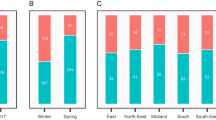Abstract
The oomycetous fungusPhytophthora infestans (Mont.) de Bary, which causes late blight disease in potatoes, is heterothallic with two known mating types, A1 and A2. From 1845 until 1980 only A1 mating type isolates were found in Europe. In 1980, the A2 mating type appeared permitting sexual reproduction. Here we show that virulence properties and DNA fingerprint patterns of isolates collected in the Netherlands before and after the appearance of A2 mating type isolates are different. Before 1980, eight different races were found in which virulence factors 1, 2, 3, 4 and 10 were most common. After 1980, new virulence factors (i.e. 5, 6, 7, 8 and 11) showed up and the diversity for virulence increased tremendously: 73 different races were detected among 253 isolates analyzed. DNA fingerprint analyses of isolates collected before 1980 revealed that, for at least two decades, only one RG-57 fingerprint genotype was present in Europe. Among 179 isolates collected after 1980 134 distinct RG-57 fingerprint genotypes were identified. The dramatic increase in genetic diversity strongly suggests that theP. infestans population in the Netherlands is now propagating sexually. The change from asexual to sexual reproduction, and the resulting increased adaptability and ability to survive outside the host, may interfere drastically with the regular disease control methods.
Similar content being viewed by others
References
Charlesworth B (1989) The evolution of sex and recombination. Trends in Ecology and Evolution 9: 264–267
Davidse LC, Looijen D, Turkensteen LJ and Wal D van der (1981) Occurrence of metalaxylresistant strains ofPhytophthora infestans in The Netherlands. European Plant Protection Organization Bulletin 15: 403–409
Drenth A, Goodwin SB, Fry WE and Davidse LC (1993a) Genotypic diversity ofPhytophthora infestans in The Netherlands revealed by DNA polymorphisms. Phytopathology 83: 1087–1092
Drenth A, Turkensteen LJ and Govers F (1993b) The occurrence of the A2 mating type ofPhytophthora infestans in The Netherlands; significance and consequences. Netherlands Journal of Plant Pathology 99, supplement 3: 57–67
Drenth A and Govers F (1993) DNA fingerprinting of the potato late blight fungus,Phytophthora infestans. pp 223–230 in: Schots A, Dewey FM and Oliver R (eds). Modern assays for plant pathogenic fungi: identification, detection and quantification. CAB International.
Drenth A, Janssen EM and Govers F (1994) Formation and survival of oospores ofPhytophthora infestans under natural conditions. Plant Pathology (in press)
Fry WE, Drenth A, Spielman LJ, Mantel BC, Davidse LC and Goodwin SB (1991) Population genetic structure ofPhytophthora infestans in The Netherlands. Phytopathology 81: 1330–1336
Fry WE, Goodwin SB, Matuszak JM, Spielman LJ, Milgroom MG and Drenth A (1992) Population genetic and intercontinental migrations ofPhytophthora infestans. Annual Review of Phytopathology 30: 107–129
Fry WE, Goodwin SB, Dyer AT, Matuszak JM, Drenth A, Tooley PW, Sujkowski LS, Koh YJ, Cohen BA, Spielman LJ, Deahl KL, Inglis DA and Sandlan KP (1993) Historical and recent migrations ofPhytophthora infestans: chronology, pathways and implications. Plant Disease 77: 653–661
Gallegly ME and Galindo J (1958) Mating types and oospores ofPhytophthora infestans in nature in Mexico. Phytopathology 48: 274–277
Goodwin SB, Allard RW, Hardy SA and Webster RK (1992a) Hierarchical structure of pathogenic variation amongRhynchosporium secalis populations in Idaho and Oregon. Canadian Journal of Botany 70: 810–817
Goodwin SB, Drenth A and Fry WE (1992b) Cloning and genetic analyses of two highly polymorphic, moderately repetitive nuclear DNAs fromPhytophthora infestans. Current Genetics 22: 107–115
Goodwin SB, Spielman LJ, Matuszak JM, Bergeron SN and Fry WE (1992c) Clonal diversity and genetic differentiation ofPhytophthora infestans populations in northern and central Mexico. Phytopathology 82: 955–961
Hohl HR and Iselin K (1984) Strains ofPhytophthora infestans with A2 mating type behaviour. Transactions of the British Mycological Society 83: 529–530
Ko WH (1980) Hormonal regulation of sexual reproduction inPhytophthora. Journal of General Microbiology 116: 459–463
Maynard Smith J (1971) What use is sex? Journal of Theoretical Biology 30: 319–335
Maynard Smith J (1978) The evolution of sex. Cambridge University Press, Cambridge
Michod RE and Levin BR (1988) The evolution of sex: An examination of current ideas. Sinauer Associates, Sunderland, Massachusetts, USA. pp 342
Mooi JC (1967) Onderzoek naar het voorkomen van ‘hogere’ fysio's vanPhytophthora infestans in de Groninger Veenkoloniën en aangrenzend gebied in 1968. Resultaten proefvelden fabrieksaardappelen 1967: 43–46
Mooi JC (1968) Onderzoek naar het voorkomen van ‘hogere’ fysio's vanPhytophthora infestans in de Groninger Veenkoloniën en aangrenzend gebied in 1968. Resultaten proefvelden fabrieksaardappelen 1968: 54–57
Mooi JC (1971) Het optreden van fysio's vanPhytophthora infestans in de Groninger Veenkoloniën en omgeven gebied in 1970 en 1971. Resultaten proefvelden fabrieksaardappelen 1971: 62–65
Niederhauser JS (1991)Phytophthora infestans: the Mexican connection. pp 25–45 in: Lucas JA, Shattock RC, Shaw DS and Cooke LR (eds).Phytophora. British Mycological Society, Cambridge University Press, Cambridge. pp 447
Rivera-Peña A (1990) Wild tuber bearing species ofsolanum and incidence ofPhytophthora infestans (Mont.) de Bary on the western slopes of the volcano Nevado de Toluca. 3. Physiological races ofPhytophthora infestans. Potato Research 33: 349–355
Sheldon AL (1969) Equitability indices: dependence on the species count. Ecology 50: 466–467
Smoot AJ, Gough FJ, Lamey HA, Eichenmuller JJ and Gallegly ME (1958) Production and germination of oospores ofPhytophthora infestans. Phytopathology 48: 165–171
Spielman LJ, Drenth A, Davidse LC, Sujkowski LJ, Gu WK, Tooley PW and Fry WE (1991) A second world-wide migration and population displacement ofPhytophthora infestans? Plant Pathology 40: 422–430
Stearns SC (1987) The evolution of sex and its consequences. Experientia. Supplementum: 55. Birkhäuser Verlag, Basel. pp 403
Author information
Authors and Affiliations
Rights and permissions
About this article
Cite this article
Drenth, A., Tas, I.C.Q. & Govers, F. DNA fingerprinting uncovers a new sexually reproducing population ofPhytophthora infestans in the Netherlands. Eur J Plant Pathol 100, 97–107 (1994). https://doi.org/10.1007/BF01876244
Accepted:
Issue Date:
DOI: https://doi.org/10.1007/BF01876244




